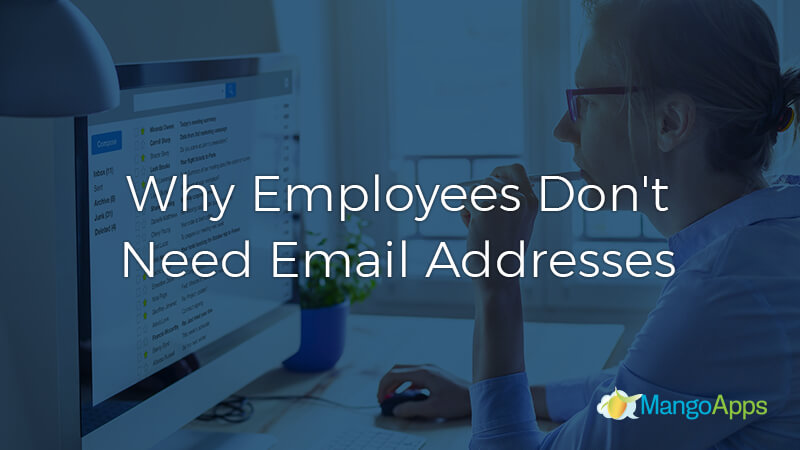
For large enterprises in today’s business world, internal communication is synonymous with migraine. As companies expand, branches tend to become less and less connected. Leaders struggle to communicate with the thousands of employees that are spread out over different geographic locations. So what is the obvious solution? Give everyone an email address, right? While providing employees with a company inbox might seem like a quick fix, it’s actually not the best solution. It’s time to consider an alternative to company email, a solution that gives employees the tools they need to communicate, collaborate, and stay in tune with company news.
5 Reasons Why Employees Don’t Need Email:
#1: Bad For The Budget
When a workforce is small, email can be an effective way to communicate with vendors, clients, and other external sources. In these specific circumstances, the cost of providing individual emails is usually an unfortunate (but necessary) business expense. In most companies, especially large enterprises, employees don’t need email addresses. As a company grows and takes on more employees, job roles tend to become much more specific. The need for external communication from an average employee greatly decreases. With emails costing companies $5 per user per month, it doesn’t make fiscal sense to increase costs for decreased needs. Being selective about who actually needs email can reduces costs by cutting down expenses and removing distracting overcommunication.
#2: Reduces Priorities
Mental fatigue is a real struggle in the modern working world, and being overwhelmed by endless email isn’t exactly helping. The ease of sending off a quick email has lead to employees spending hours every week just trying to sort, manage and understand everything being asked of them. Every new task sent via email becomes another ‘top priority’ on the never-ending list of things to get done. Employees don’t need their emails creating an abundance of tasks. When employees are focused on one goal at a time, they are happier, more focused, and more energized. This can be done by breaking down projects into smaller tasks and to-do’s. Slowing down communication by taking away email makes assignments more directional, personal, and effective.
For a deeper look at this topic, read our whitepaper “Why Activity Stream Is Replacing Email In The Workplace”
#3: Creates Ambiguity
Emails live in a bit of an ambiguous world, pushing send doesn’t necessarily mean that the message actually arrived. And even if emails don’t get lost, there is still no guarantee that it has been read by the receiver. Emails also allow employees to skirt around news by not reading or claiming to have never received a message. Unless you receive some kind of acknowledgment, it is impossible to really know that your message has been read and understood. Straightforward communication methods like digital collaboration tools remove this ambiguity and create clear understanding and expectations. Digital collaboration tools eliminate the uncertainty of email by giving you the assurance that your message has been posted, making your message more visually appealing, making it easier to communicate with groups and by letting you know who has seen your message.
#4: Unaccommodating
The working world is drastically changing, especially for big businesses. While some employees in large enterprises are probably traditional office workers who sit at a desk for the majority of the day, many are often away from a computer or don’t work around a computer at all. When they are on the go, employees don’t need email and it quickly becomes an unaccommodating method of communication. Searching email away from a desktop is difficult, and storing documents or communicating clearly with a group is even harder. Employees working in these environments, which grow larger every year, need quick access to documents, content, and information. Removing an unhelpful email inbox and offering employees a digital collaboration tool makes work easier for everyone involved.
#5: Wastes Time
Unfortunately, employee turnover is a part of business, especially within large organizations. Requiring an already busy IT department to create and cancel individual email accounts every time a termination or new hire occurs takes energy, time, and resources away from important work. Depending on your business email provider, regularly creating and deleting email users can generate additional charges as well. The average employee is already estimated to spend about 40% of his or her workday doing busy work (work tasks outside of the expected routine). Removing the burden of email management will help IT employees spend more time being productive.
MangoApps To The Rescue
MangoApps is the perfect internal communication tool to connect 100% of the workforce, especially the non-desk frontline workforce. Designed with the pitfalls of traditional email in mind, MangoApps allows employees to send targeted and personalized messages to anyone in the organization. This can be done from any device, without the distractions or frustrations of an inbox cluttered with SPAM or irrelevant messages.
Since all of the interactions happen internally, organizations can rest assured, knowing that employees are communicating safely and securely, while avoiding phishing or other malicious threats that come with email. Productivity is also boosted with built-in calendaring, notes, and to-do lists. MangoApps aims to widely replace traditional email inboxes for internal-facing employees while becoming the best way that businesses and employees interact.
To learn more about MangoApps, contact us and schedule a demo today!







